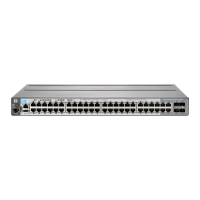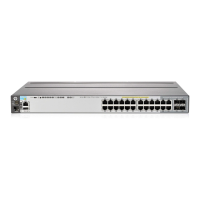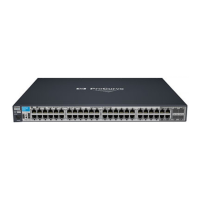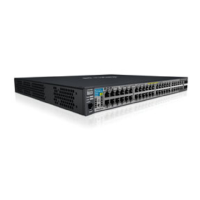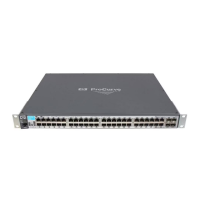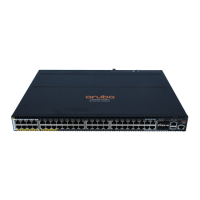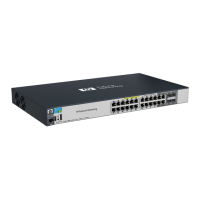Use the show running command to view the currently active IP load-sharing configuration, and
show config to view the IP load-sharing configuration in the startup-config file. (While in its
default configuration, IP load-sharing does not appear in the command output.) If IP load sharing
is configured with nondefault settings (disabled or configured for either two or three equal-cost
nexthop paths), then the current settings are displayed in the command output.
Example 23 Viewing a non-default IP load-sharing configuration
HP Switch(config)# show running
Running configuration:
; J8697A Configuration Editor; Created on release #XX.15.00
hostname "HP Switch"
module 1 type J8702A
snmp-server community "public" Unrestricted
vlan 1
name "DEFAULT_VLAN"
untagged A1-A24
ip address dhcp-bootp
exit
ip load-sharing 3*
access-controller vlan-base 2000
* Indicates a non-default IP load-sharing configuration allowing three equal-cost next-hop paths for
routed traffic with different subnet destinations. If the routing switch is configured with the default
IP load-sharing configuration, IP load-sharing does not appear in the show config or show
running command output.
Example 24 “An ECMP set with the same destination but different next-hop routers” shows
configuration of an ECMP set with routes to the same destination but through different next-hop
routers.
Example 24 An ECMP set with the same destination but different next-hop routers
HP Switch(config)# ip route 127.10.144.21/24 10.10.10.2 metric 12 distance 10
1
HP Switch(config)# ip route 127.10.144.21/24 10.10.10.3 metric 12 distance 10
1
Configures an ECMP set
with 2 different gateways to
the same destination
address.
Configuring RIP
This section describes how to configure RIP using the CLI interface.
To display RIP configuration information and statistics, see “Overview of RIP” (page 50). For more
information on configuring RIP, see “Viewing RIP information” (page 56).
Overview of RIP
Routing Information Protocol (RIP) is an IP route exchange protocol that uses a distance vector (a
number representing distance) to measure the cost of a given route. The cost is a distance vector
because the cost often is equivalent to the number of router hops between the HP routing switch
and the destination network.
An HP routing switch can receive multiple paths to a destination. The software evaluates the paths,
selects the best path, and saves the path in the IP route table as the route to the destination. Typically,
the best path is the path with the fewest hops. A hop is another router through which packets must
travel to reach the destination. If the HP routing switch receives an RIP update from another router
50 IP Routing Features
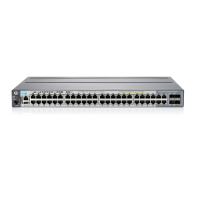
